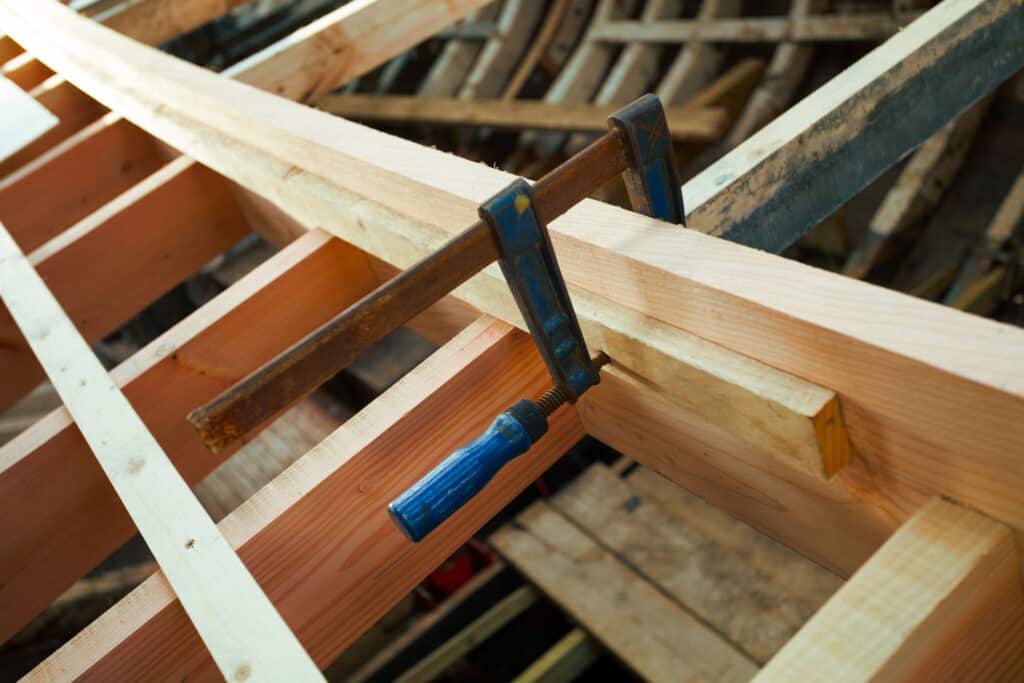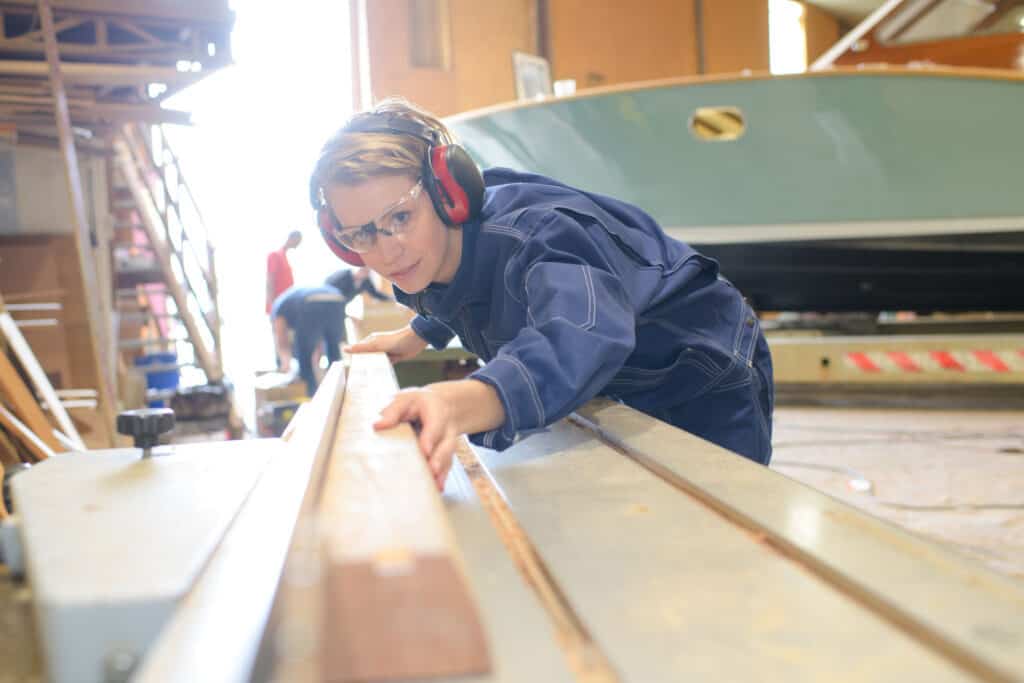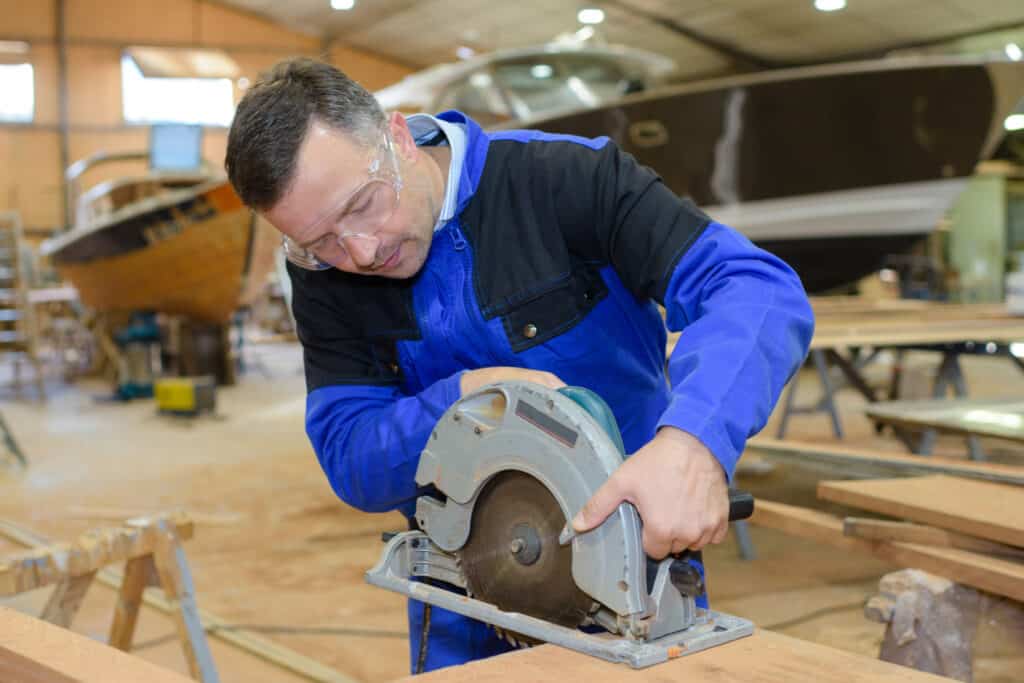Bowfishing, like the name suggests, is fishing with a bow and arrows instead of the usual fishing rod.
Boats are often used for bow-fishing, and many serious bow-fishers like to build their own deck to allow them to shoot a fish and gain a better angle of attack.
Although a deck is not required for bow-fishing, it provides the advantage of better footing, higher visibility, and a better angle.
But what materials should you use? How elevated should your deck be? Here is a step-by-step guide on how you can build your own bow fishing deck.
Why do You Want a Deck?
You do not need a deck to bow fish, however, the advantages of a bow fishing deck are worth the time and money to many bowfishers. It’s certainly a process, but the benefits can be well worth it.
More space
Decks provide more space for fishing. When you fish from a normal boat, you are often on the edge of the boat, with little room to step or move around.
Decks create more space to move around and a more solid footing for the fishers. The extra space also allows for more than one person to be fishing at a time.
Better Viewing Angle
Decks allow a person a better viewing angle and better visibility in the water to shoot fish easily.
A place to Hang Lights
Lights are valuable in bow-fishing. An advantage of having a deck is that there is more room to install and organize lights.
Stability
Rather than standing on the edge of the boat and being subject to poor footing, decks allow you to have flat-footing, and they generally come with a rail that provides additional safety and security.
Decks provide these advantages for bow fishers that make them a worthwhile investment.
1. Measure out the Area Where you want the Deck
If you add a deck to your boat it will add a lot of weight. Before doing anything, you should check your boat’s weight capacity.
After checking the capacity, estimate the weight of the material being used to make the deck.
You will be adding a lot of weight, so you should at least make sure that your boat is sturdy enough to handle the additional pounds.
You should make sure to measure the size of the deck concerning the size of your bow. Smaller boats will require smaller decks with little to no elevation.
Bigger boats may be able to handle larger, raised decks.
Keep in mind that you will be building directly on the boat’s bow, and so when preparing to build, you should lay out and measure all of your materials as well.
Make sure that your deck will be functional, provide enough room, and be sturdy enough to support those who will use it.
2. Choose and Gather Your Materials
Depending on what material you want to use to build the deck, you may have certain limitations for what you can accomplish. In general, bow decks are made from either wood or aluminum.
Wood
Pros of Using Wood: Wood is super cheap and very easy to work with. You can build the entire structure with basic tools on your property.
Cons of Using Wood: It has a lower weight capacity and is not as sturdy, especially if you are elevated. Wood also requires more upkeep even though it will not last as long.
Aluminum
Pros of Using Aluminum: The boat’s limitations are your limitations when it comes to design. Aluminum results in a much stronger deck that will hold more and last longer.
It also is significantly more convenient for cleaning and using lights (or any electricity).
Cons of Using Aluminum: It is expensive! It also is much harder to work with. Either you need to know how to cut, prep, and weld the metal or you need to hire someone who can.
After you choose what type of material you want to use, it is important to measure out and purchase enough materials to effectively build a deck on your boat.
If using aluminum, you should go with a 3/8 diamond plate or better.
3. Construction Preparation

Once you have gathered your materials, you can move on to the preparation step. This stage involves a lot of measuring, aligning, and cutting in preparation for building the actual deck.
When preparing, you should make sure that you know what type of deck you want and that you have specific plans for building that deck.
If you want a raised deck, you should make sure that you have enough material to support the deck, and if you want a flush deck, you should make sure that you can cut it to align with the boat’s shape and size.
In preparation for building a boat deck, you should make sure that you have the available tools and skillset to properly cut and build your deck.
If you are building with aluminum, you need to make sure that you have welding tools and capabilities, as well as the correct tools to cut.
Building with wood is a lot simpler but does require a saw for cutting and hammer and nails for building.
4. Determine the Height of the Deck
There are two general types: A flush deck and an elevated deck.
Flush Deck
A flush deck is when the deck sits directly on top of the boat, flush with it. Flush decks are more stable for fishing because they hold the balance of the boat.
These types of decks are preferred for smaller boats.
People also prefer flush decks because they allow the fisher to be closer to the water and the fish thereof. However, because they are so close to the water, you will have to deal with more bugs.
A flush deck is also closer to the mounted lights that attract the bugs. The angle of flush decks sometimes can be a bit harder for hitting the fish as well.
Elevated Deck
The other type of deck is an elevated deck, also called a raised deck. This type of deck allows a higher angle to be able to hit the fish.
This type of raised deck also is useful to have room for lights underneath, and having a deck farther away from the water protects you from the bugs that gather around the boat.
If you chose to go with an elevated deck, you will need to decide how far above the boat that you want it elevated. It is important to remember that having an elevated deck raises the boat’s center of gravity.
Therefore, the height of this deck should be reasonable, so it does not upset the center of gravity any further.
5. Building and Constructing

As mentioned above, there are different types of materials needed for constructing a bow fishing deck. The difference in materials makes a significant change in how the deck is constructed.
With wood materials, a boat can be constructed relatively easily. This deck can be simply done with two-by-fours and one or two sheets of plywood.
This is probably the cheapest way to build a deck. This plywood works best for a flush type of deck because it can be cut to rest directly on top of the boat with two-by-four supports.
However, building a raised boat requires larger supports on the side and an additional beam of support on the bottom.
Fortunately, working with wood is super easy. A hammer and nails should suffice for holding the deck together, and a saw can be used to cut the wood to your specifications.
If you are building a deck using aluminum, the construction process is going to be tricky. If you spend money on thick aluminum sheets, you will spend less on tubing and welding.
The structure under the deck should be made up of aluminum tubes. These tubes should be at least 1 by 2 by 1/8 inches, otherwise, the fit will feel too tight.
Aluminum requires welding or soldering to construct and put the deck together. Aluminum can be cut with a sheer or plasma cutter.
6. Know how many people are going to use it
When building a deck, you should know how many people are going to be using this deck.
If you are building a deck for yourself, then you can easily test out the sturdiness and reliability of the deck.
Better yet, you can build the deck to your exact preferences and specifications.
On the other hand, if you are building a deck for a handful of people, the deck will need to be a little bit thicker, and more sturdy so that it does not provide a liability.
When finished with the deck, it is a good idea to have multiple people on it at a time to test out the durability and sturdiness of the deck.
If you are building a commercial deck to be used by a lot of people, it is super important that the deck is very sturdy.
If you know that lots of people will be using your deck at a time, it is a good idea to add another sheet of wood or aluminum to reinforce it and make it more durable.
7. Add Lights
A big part of bow fishing involves the lights. Lights are super important for bow fishing because they help fishers with depth visibility. They also help fishers see in murky or clouded water.
When looking for bow-fishing lights, there are three key things to look for and consider:
- Watts- A watt measures electric power. When used in terms of lights, watts represent how much power the bulb needs to operate.
- Kelvins-Kelvins stands for the color temperature of the light. When bowfishing, you want a lower number of kelvins that will produce a warmer, more amber light. This color of light will be able to penetrate the water particles better.
- Lumens-Simply put, lumens describe how bright a light is. When looking for bowfishing lights, you should look for lights with a higher lumen.
When choosing lights for your boat you can also chose between LED lights and High Pressure Sodium Lights.
LED Lights: LED lights are lightweight, last a long time, and produce a very bright light that works well for bow fishing. These lights are also easily powered.
High-Pressure Sodium Lights (HPS): HPS lights are about 100 times brighter than LED light and they produce a more amber light that penetrates the water well. However, the bright light requires a bigger generator to power them. The generator will take up more room on your boat. These lights also need to warm up before peak output.
Installing Lights on the Boat: Lights on a boat should be installed directly underneath the bow-fishing deck. You can find more information on bow fishing lights here.
8. Add a Railing
One thing to consider when building a bow-fishing deck is whether or not you want to include a railing.
Railings provide an extra safety feature that prevents you from toppling over the side of your boat.
However, some people do not like to put railings on their decks because they want to get closer to the water without anything getting in their way.
If you are building a deck for just yourself, the choice to add a railing is completely subjective.
However, if you are planning on having more people on your boat, it is the safest option to have a railing.
Building a railing
Most bow fishers prefer a knee rail so that people can lean into the rail and not worry about bow limbs hitting it.
Others build waist-level rails for higher safety. The railing can be installed leaning over the water for a better fishing angle, or straight up for a greater sense of safety.
When installing the railing, there are a variety of materials that can be used. You can purchase removable bow-fishing rails.
These rails are expensive but they can save you time so that you do not have to build the railing yourself.
You can also build your own railing out of aluminum, steel, wood or, for a cheap alternative, pipes.
For more information on how to build a boat fishing deck, watch the video below.

